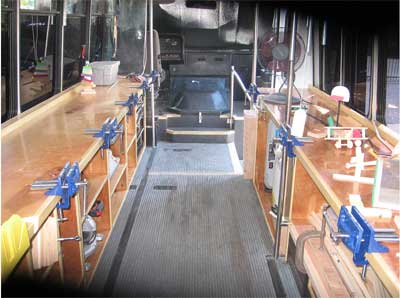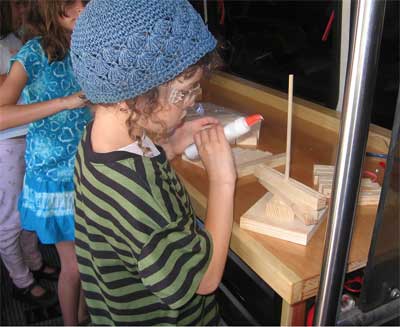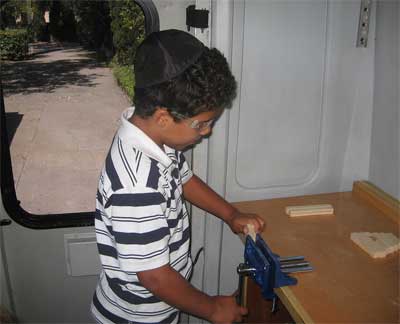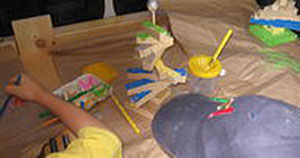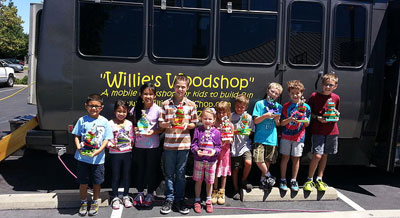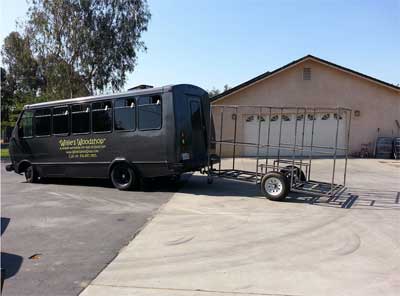
Back when Stephan Willner was in eighth grade, shop was a required class for everyone. “That was my introduction to woodworking, and it did not go very well. I struggled at first, for eight or nine weeks, before I got what the teacher was trying t get us to do.”
Then, Stephan, said, “I fell in love with it.” And today, he himself is teaching woodworking to middle schoolers – and more. Stephan’s day job is teacher of woodshop and hands-on technology in a public school, but he also owns Willie’s Woodshop, a mobile woodworking classroom run out of a converted bus.
The original inspiration came four or five years ago, when a fire occurred in Stephan’s public school classroom. A student had been playing with a cigarette lighter and caught some papers on fire; believing the fire had been put out, the class went to lunch – but the fire smoldered.
“I had to get creative,” Stephan said, since he had to teach his classes without a shop until repair and replacements could occur. “I Googled ‘woodshop without a woodshop’” and came across hits for a woman in San Diego who had been running a woodworking program, originally out of a old bread truck, then from a bus.
“I talked to her about whether she’d be OK with having a comparative bus, but it’s 500 miles away. She provided a lot of information,” Stephan said. Then his brother, an investment banker, called a couple of days later and asked “How much would that cost?” and instructed Stephan to “work out a budget and we’ll see if I can’t fund you.”
Although Stephan actually taught his public school classes in another classroom, not a bus, during the time his own shop was sidelined by the fire, the incident served as the impetus for Willie’s Woodshop. Plus, “I use both places as a laboratory for each other,” Stephan said, with ideas that work for one setting being incorporated into the other.
The Willie’s Woodshop classes target a slightly younger age bracket than the middle schoolers Stephan teaches at school. “I have done kids as young as three at preschools, but it’s mostly age 5 to 14. The average age is 10 or 11 years,” he said.
“I do a lot of work with Cub Scouts, Boy Scouts, merit badge work, and I do work with Girl Scouts,” as well as parks and recreation programs, birthday parties and classes for homeschoolers, he said.
Last year, Stephan also worked with Maker Faire® and added a CNC router, laser engraver and 3D printer to the tools on the bus, which also include scroll saws, lathes, band saw, drill press, hand tools and more. “I start out all the kids out with hand tools, and assess their skills,” he said. “After they get good at it, I let them use a nail gun.”
“For lots of kids, this is their first experience woodworking,” Stephan said. “We do simple projects like birdhouses, lots of toys, action games.” Participants have also built things like jewelry boxes or toolboxes, lollipop trees, and catapults. One of the more popular projects is a rubber band gun, Stephan said, while the most popular use of the laser engraver is for signs for the children’s rooms – things like “Keep Out!” or “Joe’s Room.”
“I try to have the kids get creative, and think of project ideas on their own,” Stephan said. “Sometimes they’ll want to combine a project, and I’ll let them fail if I think we can recover from the failure.”
Stephan attributes part of the success of his programs, both with Willie’s Woodshop and in the school setting, to the makeup of the community near Sacramento where he’s located. “The community is a blend of blue collar and technology,” he said. “There’s a push in the bay area for ‘maker’s spaces,’ and parents are starting to realize what was lost when programs were cut, and fighting to keep those programs alive.”
In the school where he teaches, for example, a block schedule means that students have four classes a day, with each class meeting every other day. It offers them the chance for an extra elective, and “the woodshop program is still thriving,” he said.
When Stephan retires from his public school job in a couple of years, he’ll move his focus to the bus woodworking with Willie’s Woodshop. “It will keep me busy, and provide a little pocket money, and keep me out of my wife’s hair,” he said. “What I’m doing right now is getting my name out there.”
He’s also making some improvements, such as building a walk-in trailer for the bus to help with equipment storage. “I’m so tired of moving stuff in and out when we get to a place,” he said. The bus does have an awning so that some kids can be working outside while some are inside – generally, machining, cutting and other rough work are done on the bus, while sanding might occur on benches outside – but the addition of a trailer with a loading ramp will be helpful, too. “The CNC is so loud, I would like to move it off the bus,” Stephan said.
Still, Stephan enjoys the program. “I’ve always been the kind of person who thoroughly enjoyed hands-on, tactile environments,” he said. “You get a sense of accomplishment; you get to touch and make things move and work. And I get to translate that into kids who never had a chance to try woodworking, and get them encouraged to stay in school, learn more and explore and create.
“It’s something I’ve been trying to do since I was 13 and in woodshop myself. My teacher took an interest in me when I was kind of rudderless, and I thought, ‘That’s what I’d like to do.’ Woodworking, and working with kids is something I’ve wanted to do since my [own] eighth grade woodworking class.”
